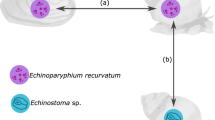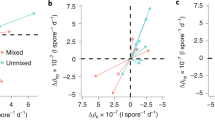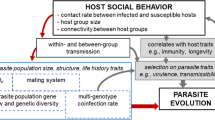Abstract
Parasite environments are heterogeneous at different levels. The first level of variability is the host itself. The second level represents the external environment for the hosts, to which parasites may be exposed during part of their life cycle. Both levels are expected to affect parasite fitness traits. We disentangle the main and interaction effects of variation in the immediate host environment, here the diatom Asterionella formosa (variables host cell volume and host condition through herbicide pre-exposure) and variation in the external environment (variables host density and acute herbicide exposure) on three fitness traits (infection success, development time and reproductive output) of a chytrid parasite. Herbicide exposure only decreased infection success in a low host density environment. This result reinforces the hypothesis that chytrid zoospores use photosynthesis-dependent chemical cues to locate its host. At high host densities, chemotaxis becomes less relevant due to increasing chance contact rates between host and parasite, thereby following the mass-action principle in epidemiology. Theoretical support for this finding is provided by an agent-based simulation model. The immediate host environment (cell volume) substantially affected parasite reproductive output and also interacted with the external herbicide exposed environment. On the contrary, changes in the immediate host environment through herbicide pre-exposure did not increase infection success, though it had subtle effects on zoospore development time and reproductive output. This study shows that both immediate host and external environment as well as their interaction have significant effects on parasite fitness. Disentangling these effects improves our understanding of the processes underlying parasite spread and disease dynamics.






Similar content being viewed by others
References
Bruning K (1991) Effects of temperature and light on the population dynamics of the Asterionella-Rhizophydium association. J Plankton Res 13(4):707–719
Bruning K (1991) Infection of the diatom Asterionella by a chytrid.1. Effects of light on reproduction and infectivity of the parasite. J Plankton Res 13(1):103–117
Bruning K, Ringelberg J (1987) The influence of phosphorus limitation of the diatom Asterionella formosa on the zoospore production of its fungal parasite Rhizophydium planktonicum. Hydrobiol Bull 21(1):49–54
Canter HM, Jaworski GHM (1981) The effect of light and darkness upon infection of Asterionella formosa Hassall by the chytrid Rhizophydium planktonicum Canter emend. Ann Bot 47(1):13–30
Canter HM, Jaworski GHM (1980) Some general observations on zoospores of the chytrid Rhizophydium planktonicum Canter emend. New Phytol 84(3):515–531
Cantin NE, Negri AP, Willis BL (2007) Photoinhibition from chronic herbicide exposure reduces reproductive output of reef-building corals. Mar Ecol Prog Ser 344:81–93. doi:10.3354/meps07059
Cobb AH, Reade JPH (2010) Herbicides that inhibit photosynthesis, in herbicides and plant physiology, 2nd edn. Wiley, Oxford
Doggett MS, Porter D (1996) Sexual reproduction in the fungal parasite, Zygorhizidium planktonicum. Mycologia 88(5):720–732
Duke SO (1990) Overview of herbicide mechanisms of action. Environ Health Perspect 87:263–271
Frost PC, Ebert D, Smith VH (2008) Responses of a bacterial pathogen to phosphorus limitation of its aquatic invertebrate host. Ecology 89(2):313–318
Gendron AD, Marcogliese DJ, Barbeau S, Christin MS, Brousseau P, Ruby S, Cyr D, Fournier M (2003) Exposure of leopard frogs to a pesticide mixture affects life history characteristics of the lungworm Rhabdias ranae. Oecologia 135(3):469–476
Haas W, Haberl B, Kalbe M, Korner M (1995) Snail-host-finding by miracidia and cercariae: chemical host cues. Parasitol Today 11(12):468–472
Hall SR, Knight CJ, Becker CR, Duffy MA, Tessier AJ, Caceres CE (2009) Quality matters: resource quality for hosts and the timing of epidemics. Ecol Lett 12(2):118–128
Hall SR, Simonis JL, Nisbet RM, Tessier AJ, Caceres CE (2009) Resource ecology of virulence in a planktonic host-parasite system: an explanation using dynamic energy budgets. Am Nat 174(2):149–162
Ibelings BW, De Bruin A, Kagami M, Rijkeboer M, Brehm M, van Donk E (2004) Host parasite interactions between freshwater phytoplankton and chytrid fungi (Chytridiomycota). J Phycol 40(3):437–453
Ibelings BW, Gsell AS, Mooij WM, van Donk E, van den Wyngaert S, Domis LND (2011) Chytrid infections and diatom spring blooms: paradoxical effects of climate warming on fungal epidemics in lakes. Freshw Biol 56(4):754–766
James TY, Letcher PM, Longcore JE, Mozley-Standridge SE, Porter D, Powell MJ, Griffith GW, Vilgalys R (2006) A molecular phylogeny of the flagellated fungi (Chytridiomycota) and description of a new phylum (Blastocladiomycota). Mycologia 98(6):860–871
Kagami M, von Elert E, Ibelings BW, de Bruin A, Van Donk E (2007) The parasitic chytrid, Zygorhizidium, facilitates the growth of the cladoceran zooplankter, Daphnia, in cultures of the inedible alga, Asterionella. Proc R Soc B 274(1617):1561–1566
Kelly DW (2001) Why are some people bitten more than others? Trends Parasitol 17(12):578–581
Korner M, Haas W (1998) Chemo-orientation of echinostome cercariae towards their snail hosts: the stimulating structure of amino acids and other attractants. Int J Parasitol 28(3):517–525
Krist AC, Jokela J, Wiehn J, Lively CM (2004) Effects of host condition on susceptibility to infection, parasite developmental rate, and parasite transmission in a snail-trematode interaction. J Evol Biol 17(1):33–40
Kuhn SF (1997) Infection of Coscinodiscus spp. by the parasitoid nanoflagellate Pirsonia diadema: I. Behavioural studies on the infection process. J Plankton Res 19(7):791–804
Lockert CK, Hoagland KD, Siegfried BD (2006) Comparative sensitivity of freshwater algae to atrazine. Bull Environ Contam Toxicol 76(1):73–79
Loot G, Poulet N, Brosse S, Tudesque L, Thomas F, Blanchet S (2011) Determinants of life-history traits in a fish ectoparasite: a hierarchical analysis. Parasitology 138(7):848–857
Lund JWG, Kipling C, Cren ED (1958) The inverted microscope method of estimating algal numbers and the statistical basis of estimations by counting. Hydrobiologia 11(2):143–170
Lund JWG, Mortimer CH, Mackereth FJ (1963) Changes in depth and time of certain chemical and physical conditions and of standing crop of Asterionella formosa Hass in North Basin of Windermere in 1947. Proc R Soc B 246(731):255–290
Maxwell K, Johnson GN (2000) Chlorophyll fluorescence—a practical guide. J Exp Bot 51(345):659–668
Mazarei M, Elling AA, Maier TR, Puthoff DP, Baum TJ (2007) GmEREBP1 is a transcription factor activating defense genes in soybean and Arabidopsis. Mol Plant-Microbe Interact 20(2):107–119
Mittra B, Ghosh P, Henry SL, Mishra J, Das TK, Ghosh S, Babu CR, Mohanty P (2004) Novel mode of resistance to Fusarium infection by a mild dose pre-exposure of cadmium in wheat. Plant Physiol Biochem 42(10):781–787
Moss AS, Reddy NS, DortaJ IM, Francisco MJS (2008) Chemotaxis of the amphibian pathogen Batrachochytrium dendrobatidis and its response to a variety of attractants. Mycologia 100(1):1–5
Muehlstein LK, Amon JP, Leffler DL (1988) Chemotaxis in the marine fungus Rhizophydium littoreum. Appl Environ Microbiol 54(7):1668–1672
Sandermann H (2000) Active oxygen species as mediators of plant immunity: three case studies. Biol Chem 381(8):649–653
Seppälä O, Liljeroos K, Karvonen A, Jokela J (2008) Host condition as a constraint for parasite reproduction. Oikos 117(5):749–753
Smith V (2007) Host resource supplies influence the dynamics and outcome of infectious disease. Integr Comp Biol 47(2):310–316
Sohn KH, Lee SC, Jung HW, Hong JK, Hwang BK (2006) Expression and functional roles of the pepper pathogen-induced transcription factor RAV1 in bacterial disease resistance, and drought and salt stress tolerance. Plant Mol Biol 61(6):897–915
Stein J (1973) Culture methods and growth measurements. Handbook of phycological methods, Cambridge University Press
Stevens RB (1960) Plant pathology: an advanced treatise, vol 3. J.G. Horsfall and A.E. Dimond, NY
Tang J, Hoagland KD, Siegfried BD (1998) Uptake and bioconcentration of atrazine by selected freshwater algae. Environ Toxicol Chem 17(6):1085–1090
Thomas F, Brown SP, Sukhdeo M, Renaud F (2002) Understanding parasite strategies: a state-dependent approach? Trends Parasitol 18(9):387–390
Vale PF, Little TJ (2009) Measuring parasite fitness under genetic and thermal variation. Heredity 103(2):102–109
Vallotton N, Eggen RIL, Escher BI, Krayenbühl J, Chèvre N (2008) Effect of pulse herbicidal exposure on Scenedesmus vacuolatus: a comparison of two photosystem II inhibitors. Environ Toxicol Chem 27(6):1399–1407
Van den Wyngaert S, Gsell AS, Spaak P, Ibelings BW (2013) Herbicides in the environment alter infection dynamics in a microbial host–parasite system. Environ Microbiol 15(3):837–847
Van Donk E, Ringelberg J (1983) The effect of fungal parasitism on the succession of diatoms in Lake Maarsseveen I (The Netherlands). Freshw Biol 13(3):241–252
Verhulst NO, Mukabana WR, Takken W, Smallegange RC (2011) Human skin microbiota and their volatiles as odour baits for the malaria mosquito Anopheles gambiae s.s. Entomol Exp Appl 139(2):170–179
Wadhams GH, Armitage JP (2004) Making sense of it all: bacterial chemotaxis. Nat Rev Mol Cell Biol 5(12):1024–1037
Warton DI, Hui FKC (2011) The arcsine is asinine: the analysis of proportions in ecology. Ecology 92(1):3–10
Wolinska J, King KC (2009) Environment can alter selection in host–parasite interactions. Trends Parasitol 25(5):236–244
Zuckerman BM, Jansson HB (1984) Nematode chemotaxis and possible mechanisms of host/prey recognition. Annu Rev Phytopathol 22:95–113
Acknowledgments
We thank Christoph Tellenbach for statistical advice and Alena Gsell for helpful comments on the manuscript. This research was funded by the ETH Board (CCES7 GEDIHAP) with additional financial support from the Special Research Fund (BOF) and the Swiss National Science Foundation (grant PBEZP3-140146).
Author information
Authors and Affiliations
Corresponding author
Electronic Supplementary Material
Below is the link to the electronic supplementary material.
ESM 1
(DOC 56.5 kb)
Rights and permissions
About this article
Cite this article
Van den Wyngaert, S., Vanholsbeeck, O., Spaak, P. et al. Parasite Fitness Traits Under Environmental Variation: Disentangling the Roles of a Chytrid’s Immediate Host and External Environment. Microb Ecol 68, 645–656 (2014). https://doi.org/10.1007/s00248-014-0434-1
Received:
Accepted:
Published:
Issue Date:
DOI: https://doi.org/10.1007/s00248-014-0434-1




